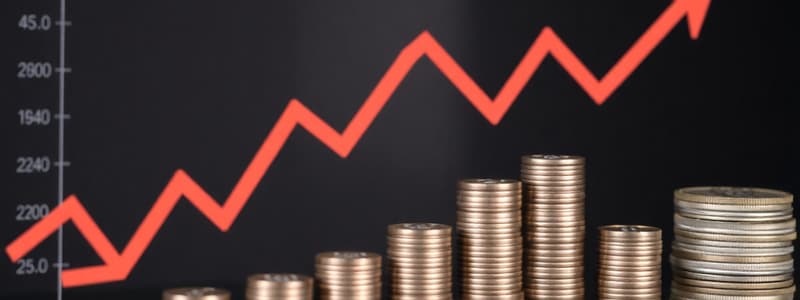Podcast
Questions and Answers
According to mainstream business cycle theory, what is the primary reason for fluctuations in real GDP?
According to mainstream business cycle theory, what is the primary reason for fluctuations in real GDP?
- Changes in government fiscal policies influencing aggregate spending.
- Variations in the growth rate of potential GDP due to technological advancements.
- External shocks such as natural disasters impacting productivity and output.
- Fluctuations in the growth rate of aggregate demand relative to the steady growth of potential GDP. (correct)
In a scenario where potential GDP increases from $1.4 trillion to $2.0 trillion, and aggregate demand increases more slowly than potential GDP, what is the likely outcome?
In a scenario where potential GDP increases from $1.4 trillion to $2.0 trillion, and aggregate demand increases more slowly than potential GDP, what is the likely outcome?
- The economy remains at full employment as the price level adjusts accordingly.
- The economy experiences hyperinflation due to increased demand.
- The economy moves to a point where real GDP growth is faster and inflation is higher than expected.
- The economy moves to a point where real GDP growth is slower and inflation is less than expected. (correct)
According to real business cycle theory, what is considered the main source of economic fluctuations?
According to real business cycle theory, what is considered the main source of economic fluctuations?
- Global financial crises impacting international trade and investment flows.
- Unpredictable changes in consumer confidence and spending habits.
- Government interventions and shifts in monetary policy.
- Random fluctuations in productivity, potentially stemming from technological changes. (correct)
Which of the following can trigger a recession according to real business cycle theory?
Which of the following can trigger a recession according to real business cycle theory?
What are the two primary effects that follow from a change in productivity, according to the real business cycle mechanism?
What are the two primary effects that follow from a change in productivity, according to the real business cycle mechanism?
According to real business cycle theory, what is the impact of a decrease in productivity on investment demand and loanable funds?
According to real business cycle theory, what is the impact of a decrease in productivity on investment demand and loanable funds?
In the context of real business cycle theory, how does a lower real interest rate influence the supply of labour?
In the context of real business cycle theory, how does a lower real interest rate influence the supply of labour?
According to the real business cycle theory, what role does money play in causing business cycles?
According to the real business cycle theory, what role does money play in causing business cycles?
Which statement reflects a significant criticism of the real business cycle theory?
Which statement reflects a significant criticism of the real business cycle theory?
What is the primary justification that defenders of the real business cycle theory offer?
What is the primary justification that defenders of the real business cycle theory offer?
Under what condition does inflation occur in the long run?
Under what condition does inflation occur in the long run?
Which of the following scenarios best describes demand-pull inflation?
Which of the following scenarios best describes demand-pull inflation?
What initial effect does an increase in aggregate demand have on the economy, starting from full employment?
What initial effect does an increase in aggregate demand have on the economy, starting from full employment?
In the context of a demand-pull inflation process, what is the primary factor that can sustain it over time?
In the context of a demand-pull inflation process, what is the primary factor that can sustain it over time?
Which of the following situations is most indicative of cost-push inflation?
Which of the following situations is most indicative of cost-push inflation?
How does the Bank of Canada typically respond to cost-push inflation to counter the higher unemployment?
How does the Bank of Canada typically respond to cost-push inflation to counter the higher unemployment?
In the event of cost-push inflation, what must occur for inflation to persist rather than being a one-time price increase?
In the event of cost-push inflation, what must occur for inflation to persist rather than being a one-time price increase?
What is the term for the economic condition characterized by a rising price level combined with decreasing real GDP?
What is the term for the economic condition characterized by a rising price level combined with decreasing real GDP?
What happens when aggregate demand increases, but the increase is expected?
What happens when aggregate demand increases, but the increase is expected?
What is a 'rational expectation' in the context of forecasting inflation?
What is a 'rational expectation' in the context of forecasting inflation?
How does the economy typically behave when the inflation forecast is correct?
How does the economy typically behave when the inflation forecast is correct?
How does the economy behave if aggregate demand grows more slowly than expected?
How does the economy behave if aggregate demand grows more slowly than expected?
What condition defines when an economy experiences deflation?
What condition defines when an economy experiences deflation?
According to the quantity theory of money, what condition leads to deflation?
According to the quantity theory of money, what condition leads to deflation?
What are the likely consequences of unanticipated deflation?
What are the likely consequences of unanticipated deflation?
Which action can be taken to end deflation, according to the economic principles discussed?
Which action can be taken to end deflation, according to the economic principles discussed?
What is represented by a Phillips curve?
What is represented by a Phillips curve?
What two factors are held constant along the short-run Phillips curve?
What two factors are held constant along the short-run Phillips curve?
With a specific expected inflation rate and natural unemployment rate, what happens if the actual inflation rate exceeds the expected rate?
With a specific expected inflation rate and natural unemployment rate, what happens if the actual inflation rate exceeds the expected rate?
What relationship does the long-run Phillips curve illustrate?
What relationship does the long-run Phillips curve illustrate?
At what point is the long-run Phillips curve (LRPC) situated on a graph?
At what point is the long-run Phillips curve (LRPC) situated on a graph?
If expected inflation falls from 10% to 6% a year, what is the immediate impact on the short-run Phillips curve (SRPC)?
If expected inflation falls from 10% to 6% a year, what is the immediate impact on the short-run Phillips curve (SRPC)?
What happens when there is a shift in the natural unemployment rate?
What happens when there is a shift in the natural unemployment rate?
In the context of the Phillips curve, which of the following scenarios would likely result in a movement along the existing short-run Phillips curve (SRPC)?
In the context of the Phillips curve, which of the following scenarios would likely result in a movement along the existing short-run Phillips curve (SRPC)?
In the context of real business cycle (RBC) theory, why might increased government spending be seen as a criticism rather than a positive intervention?
In the context of real business cycle (RBC) theory, why might increased government spending be seen as a criticism rather than a positive intervention?
According to the RBC theory, a major technological innovation that significantly boosts productivity would most likely:
According to the RBC theory, a major technological innovation that significantly boosts productivity would most likely:
What challenges might economists face in empirically distinguishing between demand-pull and cost-push inflation in a real-world scenario?
What challenges might economists face in empirically distinguishing between demand-pull and cost-push inflation in a real-world scenario?
If aggregate demand increases more slowly than potential GDP, according to mainstream business cycle theory, which of the following will likely occur?
If aggregate demand increases more slowly than potential GDP, according to mainstream business cycle theory, which of the following will likely occur?
According to real business cycle theory, what is the primary factor influencing people's decision of when to work?
According to real business cycle theory, what is the primary factor influencing people's decision of when to work?
Which of the following is a valid criticism of the real business cycle (RBC) theory?
Which of the following is a valid criticism of the real business cycle (RBC) theory?
In the context of the quantity theory of money, which condition is most likely to result in deflation?
In the context of the quantity theory of money, which condition is most likely to result in deflation?
According to the principles of ending deflation, which of the following policy actions would be most effective?
According to the principles of ending deflation, which of the following policy actions would be most effective?
How does the short-run Phillips curve illustrate the relationship between inflation and unemployment?
How does the short-run Phillips curve illustrate the relationship between inflation and unemployment?
On a Phillips curve, what does the long-run Phillips curve (LRPC) represent?
On a Phillips curve, what does the long-run Phillips curve (LRPC) represent?
What is the immediate effect on the short-run Phillips curve (SRPC) if expected inflation decreases?
What is the immediate effect on the short-run Phillips curve (SRPC) if expected inflation decreases?
Which of the following would cause a shift, instead of a movement along, the short-run Phillips curve (SRPC)?
Which of the following would cause a shift, instead of a movement along, the short-run Phillips curve (SRPC)?
Why does cost-push inflation lead to stagflation, an undesirable combination of economic conditions?
Why does cost-push inflation lead to stagflation, an undesirable combination of economic conditions?
Flashcards
What is the business cycle?
What is the business cycle?
Fluctuations in economic activity, with phases of expansion and recession.
What is real business cycle theory?
What is real business cycle theory?
Business cycle theory that attributes fluctuations to random changes in productivity.
What is the RBC impulse?
What is the RBC impulse?
The rate that results from technological change.
What is demand-pull inflation?
What is demand-pull inflation?
Signup and view all the flashcards
What is cost-push inflation?
What is cost-push inflation?
Signup and view all the flashcards
What is stagflation?
What is stagflation?
Signup and view all the flashcards
What is expected inflation?
What is expected inflation?
Signup and view all the flashcards
What is a rational expectation?
What is a rational expectation?
Signup and view all the flashcards
What is deflation?
What is deflation?
Signup and view all the flashcards
What is the Phillips Curve?
What is the Phillips Curve?
Signup and view all the flashcards
What is the short-run Phillips curve?
What is the short-run Phillips curve?
Signup and view all the flashcards
What is the long-run Phillips curve?
What is the long-run Phillips curve?
Signup and view all the flashcards
Study Notes
Business Cycle Overview
- Business cycles are difficult to explain, but easy to describe.
- Two main theories used to understand business cycles: mainstream and real business cycle theories.
Mainstream Business Cycle Theory
- Real GDP fluctuates around potential GDP, considering potential GDP grows steadily while aggregate demand varies.
- Potential real GDP starts at $1.4 trillion with full employment.
- Potential real GDP rises to $2.0 trillion, shifting the LAS curve to the right.
- An expansion occurs when aggregate demand increases, usually surpassing potential GDP.
- The AD curve then shifts to AD1.
- The price level is expected to increase to 110, thus the money wage rate is set accordingly.
- The SAS curve shifts to SAS1, the economy remains fully employed at point B.
- The price level increases from 100 to 110, as expected.
- If aggregate demand increases slower than potential GDP, the AD curve shifts to AD2 and the economy moves to point C.
- Real GDP growth slows and inflation is less than expected.
- If aggregate demand increases faster than potential GDP, the AD curve shifts to AD3.
- The economy moves to point D, real GDP grows faster and inflation is higher than expected.
- Continual increases in potential GDP, faster overall increases in aggregate demand, and variations in aggregate demand growth cause economic growth, inflation, and business cycles.
Real Business Cycle Theory
- Random productivity fluctuations are the primary cause of economic fluctuations
- Productivity fluctuations are from changes in technology, international events, climate, or natural disasters .
- RBC theory impulse: productivity growth rate from technological change
- Technological change usually occurs at a steady, moderate pace.
- Occasionally, productivity growth accelerates or decreases, making labor less productive on average.
- Rapid productivity growth leads to expansion, while decreased productivity can trigger a recession.
RBC Mechanism
- Changes in productivity result in two effects that drive expansions or contractions:
- Investment demand changes.
- Labor demand changes.
- Decreased productivity reduces investment demand, which reduces demand for loanable funds.
- Results in decline in real interest rates and quantity of loanable funds.
- Decreased productivity lowers the demand for labor.
- The supply of labor decreases as real interest rates fall.
- Employment and real wage rates decrease.
- The decision of when to work involves comparing current vs later earning potential, influenced by real interest rates.
- Intertemporal substitution has a small effect, though RBC theorists believe it is large and the key RBC mechanism.
- The real business cycle concerns real, not nominal or monetary factors.
- Changes in money only affect the price level, not real resources.
- Technological change drives both business cycles and economic growth in RBC theory.
Criticisms and Defense of RBC Theory
- Criticisms:
- The money wage rate is sticky, which conflicts with RBC theory's assumptions.
- Intertemporal substitution is too weak to explain fluctuations in employment with small wage changes.
- Productivity shocks can result from changes in aggregate demand, not just technological change.
- Defenses:
- RBC theory explains macroeconomic facts about the business cycle and economic growth, and is a single explanation for both.
- RBC theory aligns with microeconomic evidence on labor supply, labor demand, investment decisions, and income distribution.
Inflation Cycles
- Inflation occurs in the long run if quantity of money grows faster than Real GDP
- In the short run, inflation can be started by factors, that interact with real GDP
- Two sources of inflation: demand-pull and cost-push
Demand-Pull Inflation
- Inflation starts when aggregate demand increases.
- Can be initiated by: reduced interest rates, increased money supply, government spending, tax cuts, increased exports, or increased investment.
- An increase from full employment shifts AD curves rightward
- As the AD curve shifts, money wage rates increase and SAS curve shifts left
- The price level rises and real GDP falls back to potential GDP
- The inflationary gap emerges as the price level and real GDP increases
- The continuous increase in ad leads to demand pull inflation
- A sustained demand-pull inflation requires an ongoing increase in the money supply.
- Canada experienced a demand-pull inflation in the early 1970s, with double-digit inflation by 1974.
Cost-Push Inflation
- Starts with increasing costs, such as increased money wage rates or raw material
- Cutting of production and raising of oil prices leads to decreased aggregate supply and a shift in the SAS curve leftward
- Real GDP decreases and price level increases as aggregate supply decreases
- The decreasing of aggregate supply leads to aggregate demand response
- The Bank of Canada increases aggregate demand to counter higher unemployment.
- Real GDP increases and the price level further rises.
Aggregate Demand Response
- The initial increase in input costs causes a one-time rise in the price level, which will not cause inflation
- However, aggregate demand must increase for inflation to occur.
- Canada's Central Bank must respond to the unemployment and increase the money supply for increased aggregate demand
- Continuous oil price increase to keep relative price higher will cause a response from the Bank of Canada to increase the quantity of money
- Stagflation combines a rising price level with decreased real GDP.
- Canada experienced cost-push inflation during the 1970s when the Bank responded to rising OPEC oil prices.
Expectation of Inflation
- Expected aggregate demand increase impacts the price level.
- Workers money wage rates increase with the expected rise in price level
- The price level then rises as expected and real GDP remains at potential Real GDP
- To expect inflation, people must forecast it rationally: the best forecast available based on all relevant information.
- A rational expectation is not necessarily accurate, but is the best available.
Inflation and the Business Cycle
- The economy operates at full employment when inflation forecasts are correct.
- The inflation rate will exceed the expected rate, and the economy will act like in a demand-pull inflation if aggregate demand grows faster than expected
- Real GDP falls below potential, inflation slows, and the economy acts like in a cost-push inflation if aggregate demand grows more slowly than expected
Deflation
- Characterized by a consistent decline in the price level
- Causes include persistently slower growth in aggregate demand relative to aggregate supply.
- Quantity Theory and Deflation
- Inflation rate = Money growth rate + Rate of velocity change - Real GDP growth rate
- Deflation rate = Money growth rate < Real GDP growth rate - rate of velocity change
- For example:
- Japan experienced 0.8% Real GDP growth rate, 2.5% money growth rate, and -3% change in velocity change
- 2.5 + (-3) -0.8 =-1.3% deflation
- Consequences of deflation include redistributing income and wealth, reducing real GDP and employment, and diverting resources away from production.
- Deflation can be ended by increasing the growth rate of money.
- Money growth rate must exceed real GDP growth rate minus the rate of velocity change.
Phillips Curve
- Illustrates the correlation between inflation and unemployment rates.
- There are two types: short-run and a long-run Phillips curve.
Short-Run Phillips Curve
- Represents the tradeoff between inflation and unemployment, assuming constant expected inflation and natural unemployment rates.
- If the actual inflation rate exceeds the expected rate, unemployment decreases.
- Increases in unemployment occur if the actual inflation rate is less than the expected rate.
Long-Run Phillips Curve
- Shows the connection between inflation and unemployment when actual inflation equals expected inflation.
- The curve is vertical at the natural unemployment rate
- Changes in inflation expectations do not affect unemployment.
- The SRPC and LRPC intersect at the expected inflation rate.
- Reduced expected inflation leads SRPC to shift downwards and vice versa.
- Changes in the natural unemployment rate prompt shifts in both the LRPC and SRPC.
Studying That Suits You
Use AI to generate personalized quizzes and flashcards to suit your learning preferences.





